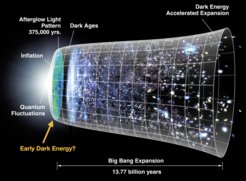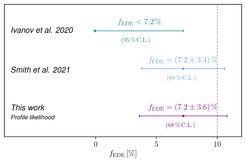Relieving the Hubble tension with Early Dark Energy
Different measurements of the Hubble constant, the current expansion rate of our universe, show a discrepancy known as the Hubble tension. This could hint towards new physics beyond the standard model of cosmology. Using a complementary statistical method, researchers at MPA now narrow down possible new physics in the early universe and constrain the fraction of a proposed new component: early dark energy.

The universe is 13.8 billion years old – or is it really? The age of the universe is closely related to the so-called Hubble constant, which measures the current expansion rate of the universe. A higher Hubble constant means the universe expands faster and is therefore younger, while a more slowly expanding universe is older. Measurements of the Hubble constant have become more and more precise in recent years and revealed a puzzling observation: different experiments gave slightly different values of the Hubble constant and consequently different answers about how old our universe is. Could this discrepancy be a hint towards new physics beyond the standard model of cosmology?
If one measures the velocity of galaxies around us, one finds that the vast majority of galaxies observed on the night sky move away from our galaxy, the Milky Way – this is known as the Hubble-Lemaître law and it is direct evidence for the expansion of the universe: the space between all galaxies increases. Seen from Earth, this results in all galaxies drifting away from us. In recent years, astrophysicists have measured the receding velocity of galaxies to very high precision. For these measurements, they observe Type Ia supernovae, very bright explosions of stars that can be seen even in very distant galaxies. The Hubble constant can then be determined to be 73.0 km/s/Mpc with an uncertainty of ± 1.0 km/s/Mpc.

An alternative way to measure the Hubble constant involves an even more extreme time in the history of the universe: Going back to the beginning of the universe, all matter was densely packed in a hot plasma. The afterglow of this hot plasma can still be observed today in form of the Cosmic Microwave Background – a snapshot of the very early universe (left in Fig. 1). Astrophysicists use high-resolution temperature maps of this afterglow to measure the ingredients of the universe: the baryonic “normal” matter makes up only about 5% of the composition of the universe, while the rest is made up by two components that have not been directly detected so far: about 70% of dark energy and 25% of dark matter. With this composition, physicists can calculate the Hubble constant to be 67.4 km/s/Mpc with an uncertainty of ± 0.5 km/s/Mpc – a value that is about 9% lower than the value measured from the velocity of galaxies around us (Fig. 2). This discrepancy, known as the Hubble tension, could be an indication that there is another ingredient in the universe that has not been observed yet.
One candidate of this additional ingredient is “early dark energy”. Similar to dark energy, early dark energy leads to an accelerated expansion of space. However, in contrast to dark energy, this new type of energy would appear in the early universe, before the Cosmic Microwave Background was emitted, and it would decay very quickly, well before the first galaxies form (Fig. 1). This change in the composition of the universe would change the calculations to predict the Hubble constant from the Cosmic Microwave Background radiation and could explain the discrepancy to the measurement using Type Ia supernovae.
Researchers at MPA have now narrowed down the properties of this new type of energy, using a complementary statistical method known as the profile likelihood, which is common in particle physics but rarely used in cosmology. They explored both Cosmic Microwave Background data from ESA’s Planck satellite and data from the BOSS galaxy survey. This survey maps the positions of millions of galaxies to trace the large-scale structure of the universe and gives insights about the composition of the universe. However, there was a disagreement in the literature on how much early dark energy was allowed by these two data sets. Two different groups found opposing answers to this question: one using a reduced model, which is difficult to generalise to the full early dark energy model, and one using the standard statistical methods based on Markov Chain Monte Carlo (MCMC), which finds that only a very small fraction of early dark energy is allowed by the data — not enough to solve the Hubble tension.

Using the statistical method based on the profile likelihood, the MPA researchers could resolve this confusion between the two methods used in the literature. They constructed a robust confidence interval for the fraction of early dark energy that is allowed by the data and found evidence that the standard statistical method based on MCMC is plagued by technical effects known as marginalisation, which can lead to biased results. The fraction of early dark energy allowed by the data is between 3.6% and 10.8% (at 68% confidence level), an amount that could alleviate or potentially solve the Hubble tension (Fig. 3).
The statistical methods used here open up the possibility to explore further cosmological data sets without being subject to marginalisation effects. This is necessary to give a more complete picture on whether early dark energy is the explanation for the Hubble tension and can deepen our understanding of the composition of the universe.














